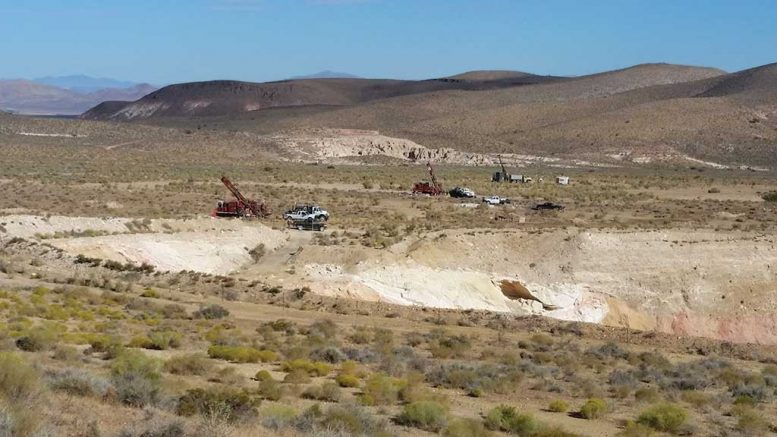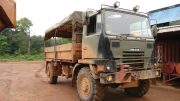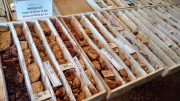Before he founded International Tower Hill Mines (TSX: ITH; NYSE-AM: THM) in the mid-2000s and discovered the Livengood deposit in Alaska — a development project that now has an estimated 19.7 million oz. gold — Jeffrey Pontius worked for seven years as the U.S. and North American exploration manager for AngloGold Ashanti (NYSE: AU). It was during his time at the South African miner that the geologist led the discovery and development team of its Cripple Creek deposit in Colorado 1991.
AngloGold was an early investor in International Tower Hill, and so when Pontius decided in 2011 to leave the company he created and spin out some of its assets into a junior called Corvus Gold (TSX: KOR; US-OTC: CORVF), AngloGold Ashanti became one of the junior’s cornerstone investors. Since then the gold major has increased its stake in Corvus Gold to 19.9%.
“It’s kind of a bet on the jockey,” jokes Pontius, Corvus Gold’s president and CEO. “I’d been driving their exploration programs for a long time before I went out on my own with International Tower Hill and Corvus, so they’ve been in basically from the beginning of Corvus, but they’ve moved up their share position substantially over the last year.”
Corvus Gold’s North Bullfrog-Mother Lode project is a multimillion-ounce gold property with five known deposits in the Bare Mountain mining district of Nevada’s Nye County.
Mother Lode is north of the Bare Mountains and is connected to the southeast corner of the North Bullfrog property for a total land package of 37.5 square kilometres.
Pontius was attracted to this part of Nevada — a two-hour drive north of Las Vegas, along U.S. Highway 95 — because compared to the rest of the state, he says, it was relatively untouched. The exception was Barrick Gold’s (TSX: ABX; NYSE: GOLD) past-producing Bullfrog mine, 10 km south of Corvus’ North Bullfrog property. This mine produced 3 million oz. gold before shutting down in 1999.

An aerial view of the main resource at Corvus Gold’s North Bullfrog project. Credit: Corvus Gold.
“At the time we came into the district in 2008–2009 — first with International Tower Hill, and eventually Corvus — the district had not received any modern-day exploration,” Pontius recalls. “Usually Nevada is a place that is highly explored, lots of drilling, and it has gone through many, many periods of exploration since gold broke out of the US$300 per oz. range. But this area had not, and it was a great opportunity for Corvus to take advantage of an area that just had not seen diligent exploration for literally 25 years, and so that’s why Corvus has had a lot of success.”
Its orphan-like quality was even more remarkable, he says, because there was a lot of mineralization in the district outcrops.
By 2013, Pontius and his team had found three open-pittable deposits on its North Bullfrog property, which extend up to 200 metres.
Those discoveries were followed last year by the North deposit, a mineralization area 100 metres from the Mother Lode deposit on its Mother Lode property, 12 km southeast of North Bullfrog.
The Mother Lode deposit fed a historic open-pit mine that produced 35,000 oz. gold at an average grade of 1.8 grams gold, before it was shut down in 1989. The property ended up in the hands of Glamis Gold before it was acquired by Goldcorp (TSX: G; NYSE: GG).
Corvus picked up Mother Lode from Goldcorp in 2017, but Pontius says he had had his eye on the property long before that.
“Corvus had looked at Mother Lode for five or six years, but couldn’t do anything until the final sign-off on the reclamation was done, and then once that happened, we approached Goldcorp,” he says.
North Bullfrog has two styles of precious metal epithermal mineralization — high-grade, structurally controlled fissure veins and associated stockwork zones, and low-grade, disseminated or replacement deposits within altered volcanic rocks. By contrast, 60% of the mineralization at Mother Lode is contained in sulphide minerals (predominantly pyrite), and requires preparation of a sulphide concentrate, followed by oxidation that will produce a filter cake from which the gold can be leached.
In November, Corvus completed a preliminary economic assessment (PEA) that looked at combining North Bullfrog and Mother Lode into one larger project.
“Mother Lode provides us some very good grades to support a large milling operation that will allow us to take advantage of the vein system we have at North Bullfrog, and that material will be trucked down to Mother Lode,” Pontius says. “Mother Lode will be the largest amount of tonnes for milling, but the mill will process mineralized vein material from North Bullfrog and sediment-hosted material from Mother Lode.”
The PEA estimated a nine-year mine life producing 350,000 oz. gold annually during the first four years and 230,000 oz. gold a year for the last five years. The study estimated total capital investment of US$505 million and payback in 2.2 years of start-up, with a mill at Mother Lode and heap-leach operations at both North Bullfrog and Mother Lode.
For the mill, the combined project has a measured resource of 9.3 million tonnes at an average grade of 1.59 grams gold per tonne for 475,000 contained oz. gold, and an indicated resource of 18.2 million tonnes grading 1.68 grams gold for 988,000 oz. gold. Inferred resources add 2.3 million tonnes of 1.61 grams gold for 118,000 contained oz. gold.

An aerial view of Corvus’ Mother Lode project in Nevada. Credit: Corvus Gold.
For the oxide, run-of-mine, heap-leach component of the project, the combined deposits have a measured resource of 34.6 million tonnes grading 0.27 gram gold for 305,000 contained oz. gold, and an indicated resource of 149.9 million tonnes at a grade of 0.24 gram gold for 1.15 million contained oz. gold. Inferred resources add 78.7 million tonnes grading 0.26 gram gold for 549,000 contained oz. gold.
Pontius says the recently discovered North deposit is a continuation of the Mother Lode stratabound orebody.
“It looked like the main zone at the Mother Lode resource was thinning and our expectation was that we were getting to the edge of it maybe, but as we did more step-out drilling we got into much thicker zones of mineralization and better grade, so it looks like we’ve run into another pod, or deposit, to the north, that is like our Mother Lode to the south — but it’s actually even bigger and thicker. Right now our strategy is to just continue to do step-out drilling and evaluate as it goes to the north. Think about it like beads on a string.”
The company has only drilled half a dozen holes into the North deposit and plans to continue to drill it this year. It will test six new targets at North Bullfrog, including the prospective Jasperoid target, which early work suggests could be another sediment-hosted system like Mother Lode.
Mother Lode is the higher-grade deposit of all five of the deposits on the combined project, and success finding more ounces at the North deposit will be critical to expand the resources to sustain the mill.
“We want to add more mill material into the production profile so that we can keep the mill grades up and we can increase the actual overall production base for these ounces, as we go further out into the mine life,” he says. “To be honest, most of my history has been with bigger companies, and we’re trying to build a project that is going to be a mine of merit — or a marquee project — for any scale of company, and so 300,000 oz. gold a year is a pretty damn good mine, if you can extend that for about eight years in any scenario, whether you be Barrick, Newmont or AngloGold — so it’s important for us to demonstrate the scale of the project that would fit in the production profile of any mine these guys would want to have.”
Corvus is just finishing a 15,000-metre drill program it started last year. Once that is completed, it will drill 10,000 metres at North Bullfrog to test new targets, and a further 10,000 metres at Mother Lode.
Recent assays from two holes drilled along the eastern boundary of the Mother Lode deposit and a third hole drilled at the northernmost end of the deposit returned results including 126 metres of 1.85 grams gold, including 18 metres of 4.2 grams gold and 10.7 metres of 6.3 grams gold, starting from 410 metres downhole.
Mother Lode represents a new type of sediment-hosted deposit in the Walker Lane mineral belt and the Southwestern Nevada Volcanic Field, Pontius says.
“For a geologist, it’s a very cool project to work.”
It is unique in the fact that the upper part of the deposit is hosted in young volcanoclastic rocks that have a lot of carbonated material in them, which created open spaces when mineralizing fluids came in, and those sit on top of the older Paleozoic rocks that would normally be host rocks you’d see in northern Nevada, he says.

A district map of Corvus’ Nevada properties. Credit: Corvus Gold.
Those rocks are mineralized as well, he says. The contact between the young volcanics and the underlying old carbonate rocks is an unconformity, and fluids passing along that unconformity created a jasperoid breccia that channelled surface waters over the past 10 million years, and basically oxidized all the material down below that unconformity. The upper part of the young volcanoclastic rock is a tight, impermeable clay layer preserving sulphide mineralization above the unconformity, so the bottom of the deposit is all oxide, and the upper part is sulphide. He calls it “upside-down” compared to a more typical orebody with oxides on top.
“It’s a little odd, but it has great continuity, it’s hosted in sedimentary rocks, it’s tabular, and it has the grade profile we would see out of a normal sediment-hosted deposit in northern Nevada,” he says. “The big difference between Mother Lode and the true ‘Carlin-type’ system is that at Mother Lode, the mineralization is near surface and lower temperature, so epithermal, and 12.5 million years in age, versus 40 million years up north. In addition, the gold habit and sulphide mineralogy is different with Mother Lode, with the sulphides being pyrite and with the gold occurring as native gold and electrum on the margins of the sulphide grains, versus gold in arsenian pyrite rims at Carlin.”
Pontius acknowledges that the district is complicated from the standpoint of its volcanic stratigraphy and structural setting, and says that given Corvus’ history in the area, he often gets together with groups at Coeur Mining (NYSE: CDE) and AngloGold Ashanti that are exploring nearby to talk about what’s going on geologically in the region.
The geologist says Coeur Mining’s SNA deposit 1.5 km south is likely an extension of the Mother Lode system, because he has access to quite a bit of drill data from the area when Corvus acquired Mother Lode. “Geologically, you can connect them together — SNA is basically the lower-grade, carbonated-hosted part of the Mother Lode deposit.”
Pontius notes that Coeur Mining bought Northern Empire, which had drilled holes right on the property line south. “It’s probably going to be one large open pit that will include both projects, and have a strike length of probably 2 to 3 km, at least,” he predicts. “It’s going to be a big deposit — it’s not the likes of a Goldstrike or Gold Quarry, but it would be a good-sized deposit.”
Meanwhile, 5 km north of North Bullfrog is Renaissance Gold’s (TSXV: REN; US-OTC: RNSGF) Silicon project, in which AngloGold Ashanti is earning an ownership position.
“They haven’t released any data on Silicon, but Anglo’s CEO talked about it at the recent BMO conference in Florida, and said they have some synergies with their shareholding in Corvus,” Pontius says. “We have one of the largest resources and land packages in the area and are the most active exploration group in the district right now, but AngloGold is doing lots of work to the north of us, and have a vested interest in the district, as well.”
In addition to AngloGold Ashanti, Corvus shareholders include Toqueville Asset Management (17.6%) and Van Eck Global (9.6%).
“Our second-largest shareholder is Tocqueville, John Hathaway’s group out of New York, and Joe Foster with the Van Eck Group, and those guys have been hanging in there with me for a while now, so it’s kind of like having a great family.”
Corvus management and employees own 7.2%.
At press time, Corvus was trading at $2.33 per share in a one-year range of $1.92 to $3.39.
The company has 110 million shares outstanding for a $258-million market capitalization.






Great article and good graphics.